Abstract
T cell receptor beta (TcR beta) chain gene rearrangements have been reported in cases of angioimmunoblastic lymphadenopathy (AILD) and provided evidence for the presence of clonal T cell proliferations in this disorder. Twenty-three cases of AILD and two cases of hyperimmune reaction (HR) were investigated. In the two HR cases, essentially the same histologic pattern was present as in AILD but lymph node follicles were hyperplastic. Both HR cases showed germline configuration for the TcR and immunoglobulin heavy chain (IgH) genes. All other patients diagnosed with AILD had clonal rearrangements for TcR gamma and beta chain genes. In addition, seven out of these cases had clonally rearranged their IgH genes. These two different rearrangement patterns (TcR with or without Ig gene rearrangement) correlated to immunohistochemical and clinical data. Cases with TcR but without Ig gene rearrangements (group I) exclusively showed CD4+ proliferating T cells, whereas those cases with TcR and Ig gene rearrangements had significantly elevated numbers of CD8+ proliferating cells (group II). Group II patients significantly more often presented with hemolytic anemia and went into transient remission spontaneously or under steroid treatment. Group I patients, however, had a higher response to chemotherapy and a longer survival time. These data show that, based on different rearrangement patterns, it is possible to divide AILD into two different groups with distinct immunophenotypic properties and differences in clinical parameters. Immunogenotyping in AILD thus will have prognostic and therapeutic implications.
Full text
PDF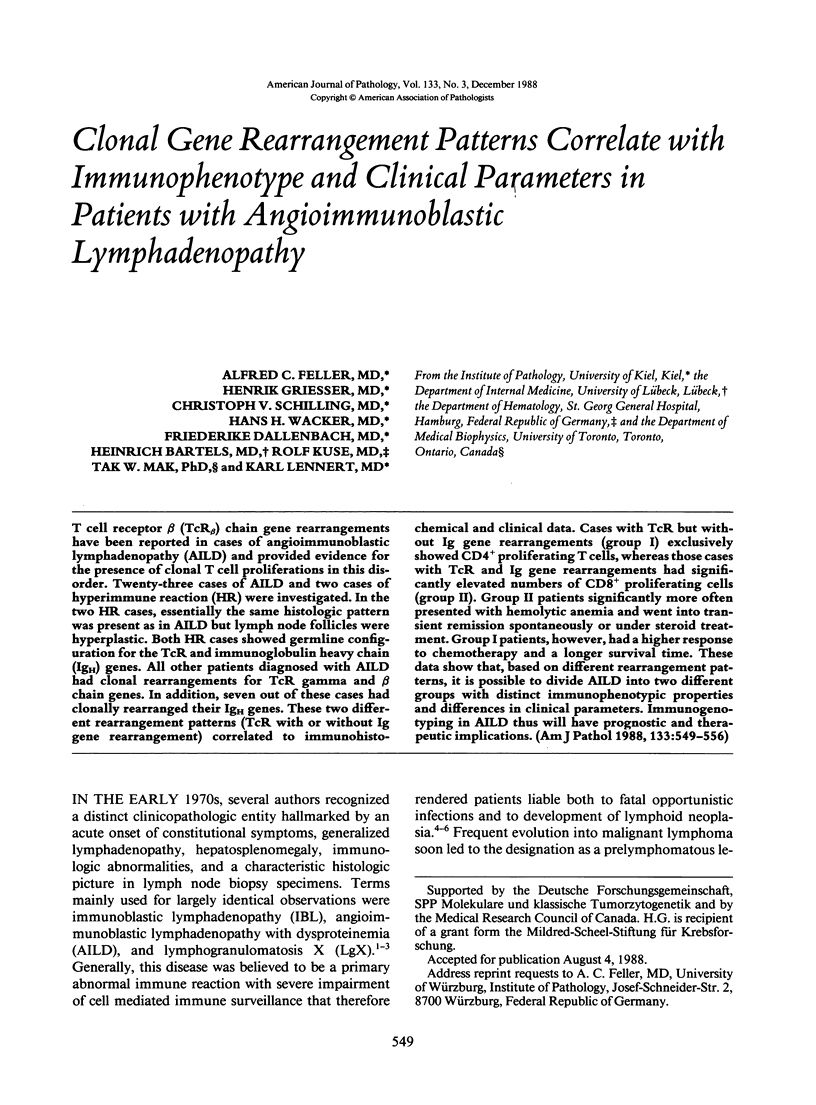
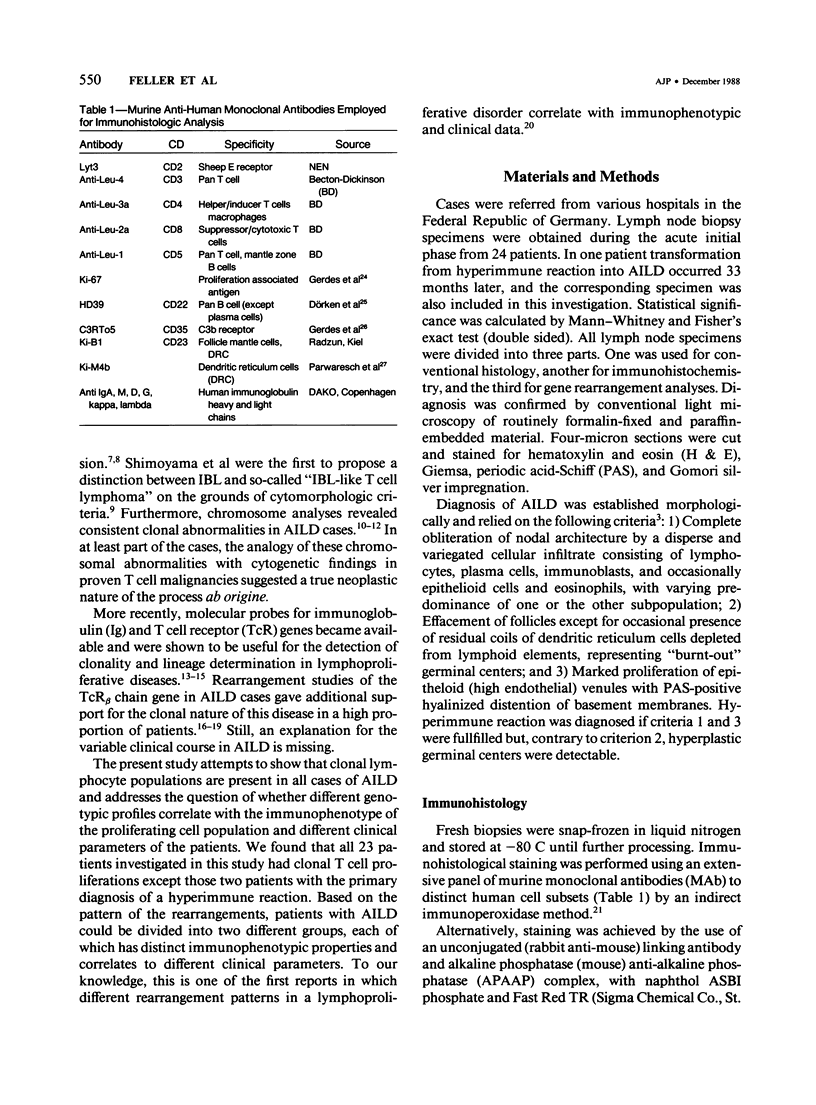
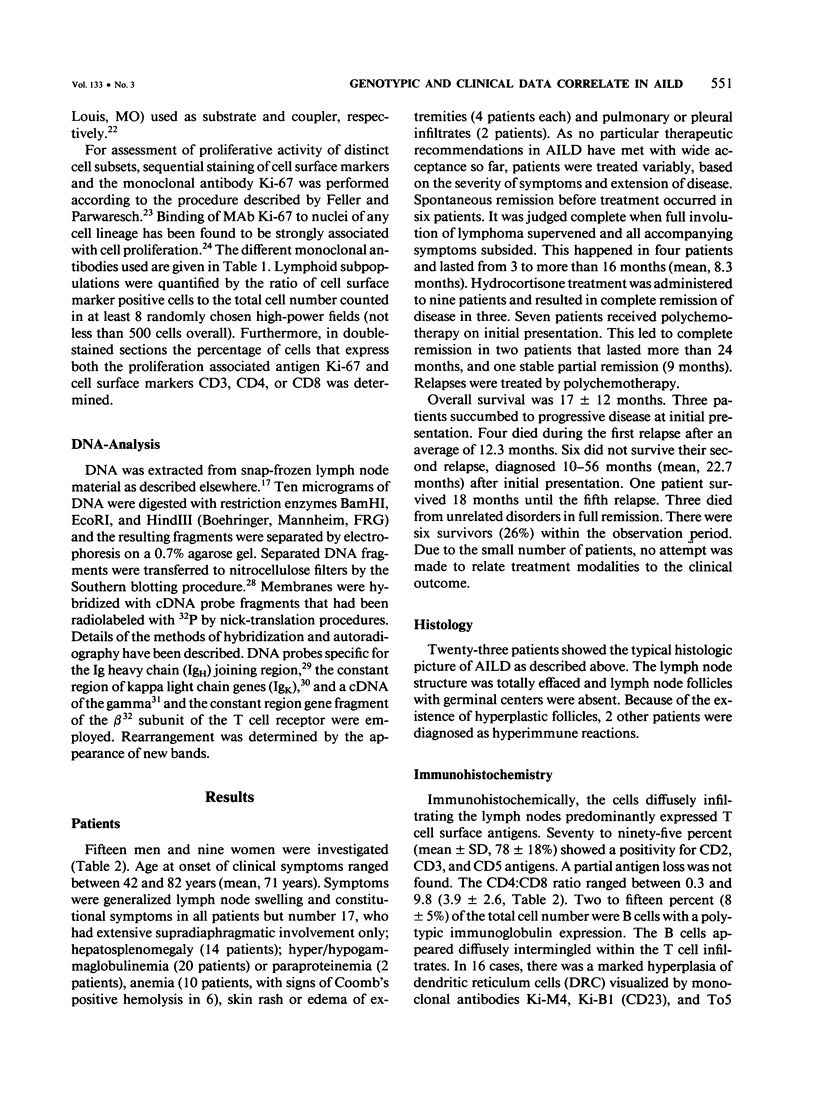
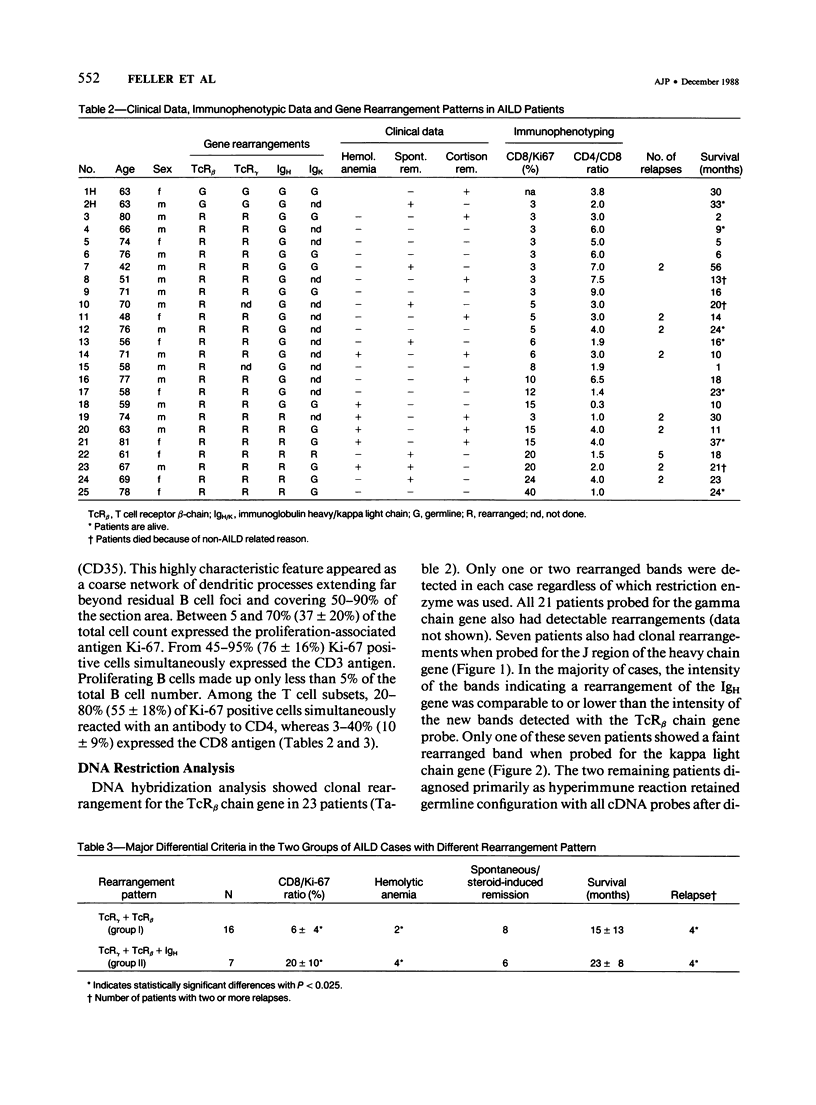
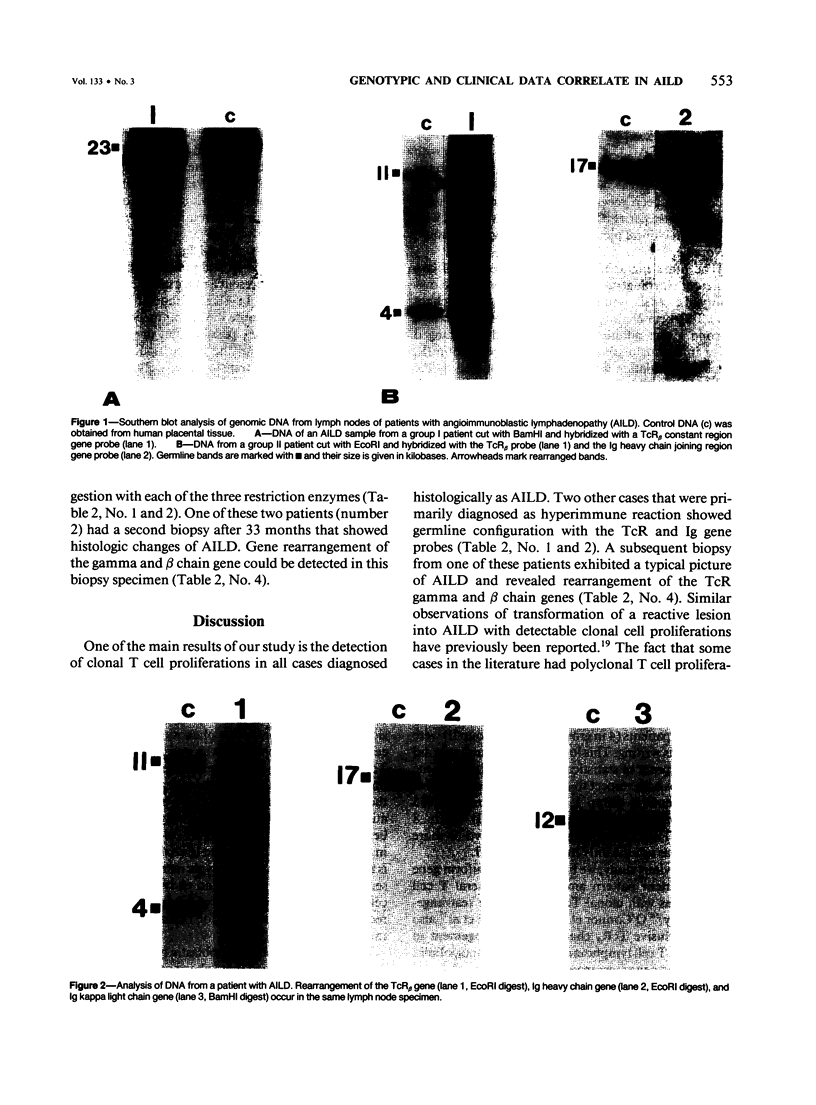
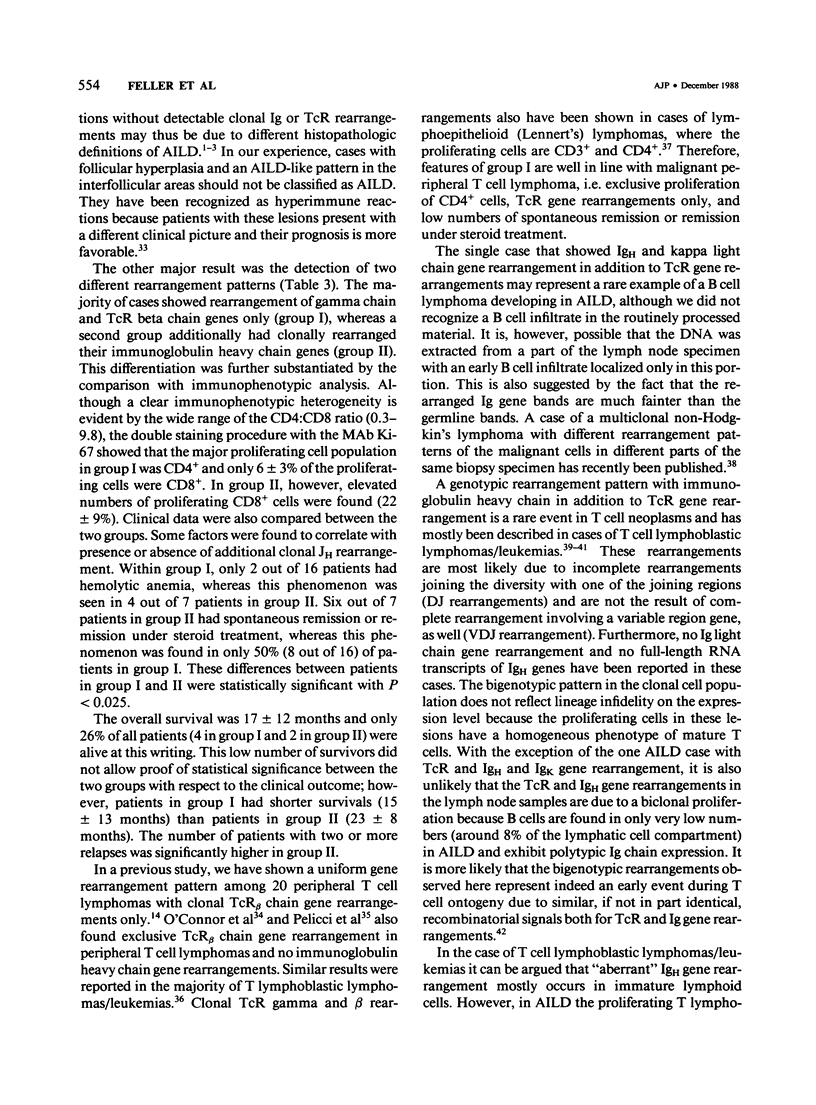
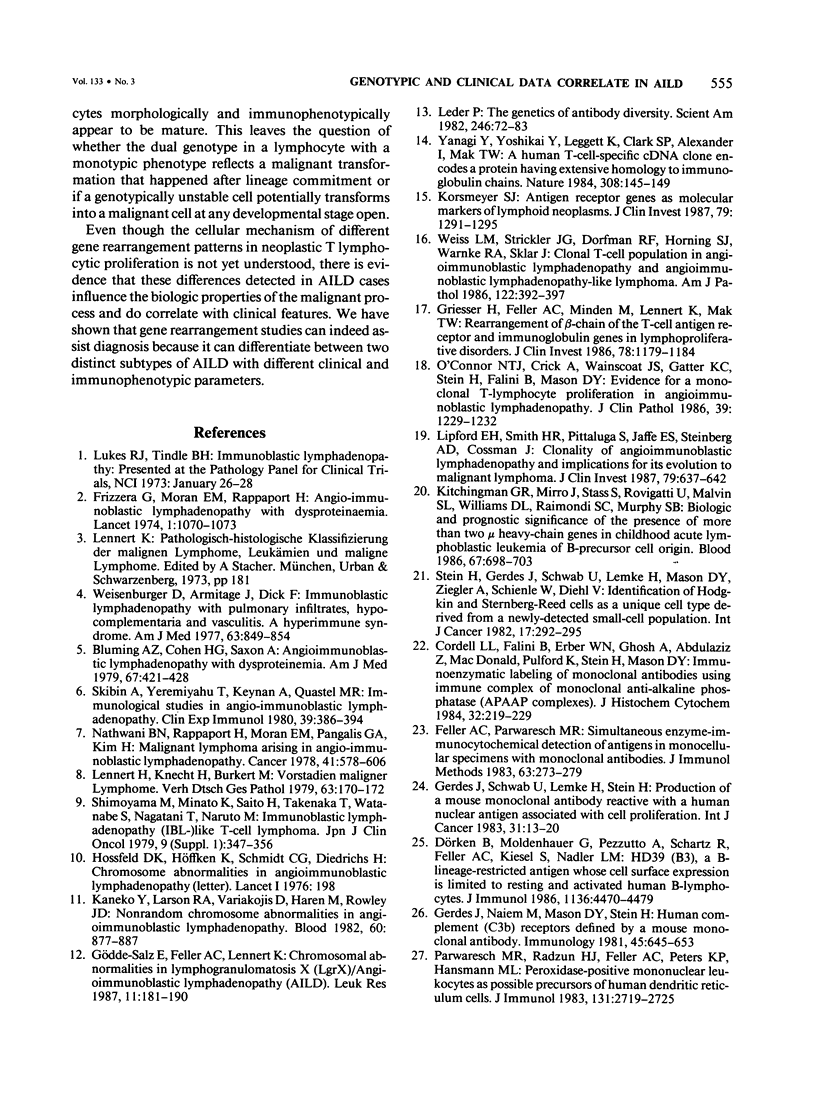
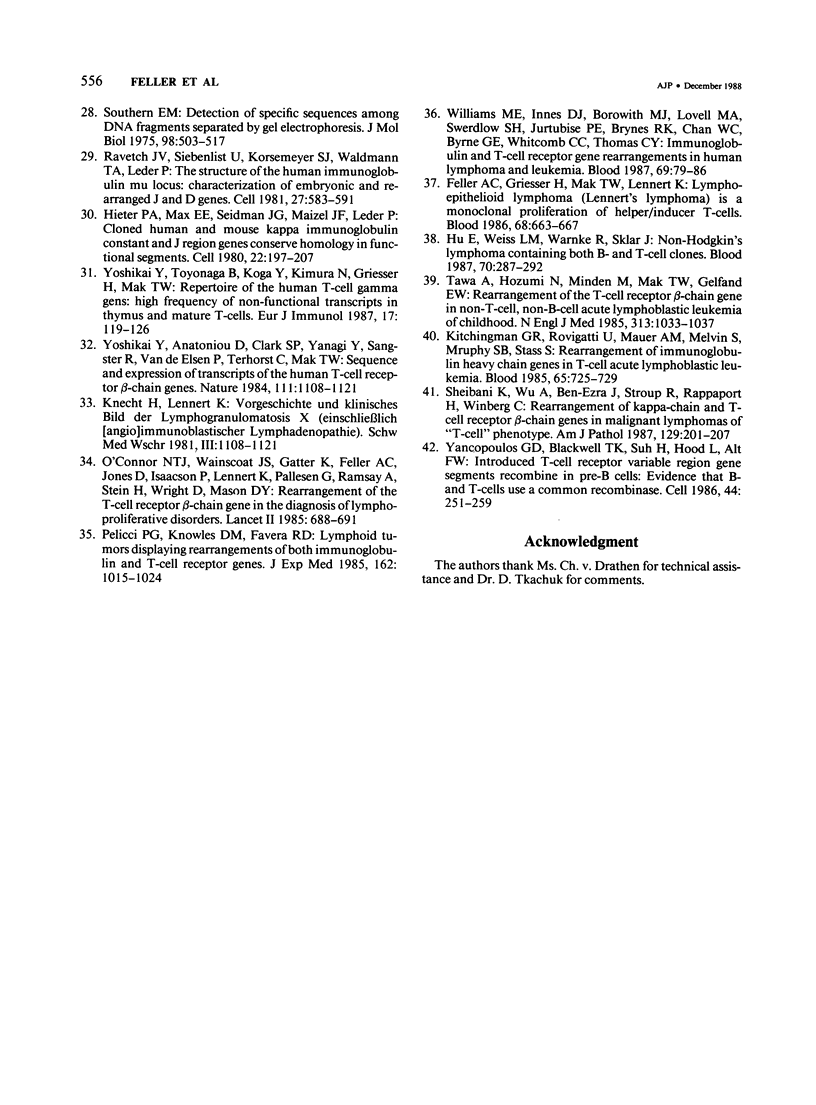
Images in this article
Selected References
These references are in PubMed. This may not be the complete list of references from this article.
- Bluming A. Z., Cohen H. G., Saxon A. Angioimmunoblastic lymphadenopathy with dysproteinemia. A pathogenetic link between lymphoid proliferation and malignant lymphoma. Am J Med. 1979 Sep;67(3):421–428. doi: 10.1016/0002-9343(79)90788-5. [DOI] [PubMed] [Google Scholar]
- Cordell J. L., Falini B., Erber W. N., Ghosh A. K., Abdulaziz Z., MacDonald S., Pulford K. A., Stein H., Mason D. Y. Immunoenzymatic labeling of monoclonal antibodies using immune complexes of alkaline phosphatase and monoclonal anti-alkaline phosphatase (APAAP complexes). J Histochem Cytochem. 1984 Feb;32(2):219–229. doi: 10.1177/32.2.6198355. [DOI] [PubMed] [Google Scholar]
- Dörken B., Moldenhauer G., Pezzutto A., Schwartz R., Feller A., Kiesel S., Nadler L. M. HD39 (B3), a B lineage-restricted antigen whose cell surface expression is limited to resting and activated human B lymphocytes. J Immunol. 1986 Jun 15;136(12):4470–4479. [PubMed] [Google Scholar]
- Feller A. C., Griesser G. H., Mak T. W., Lennert K. Lymphoepithelioid lymphoma (Lennert's lymphoma) is a monoclonal proliferation of helper/inducer T cells. Blood. 1986 Sep;68(3):663–667. [PubMed] [Google Scholar]
- Feller A. C., Parwaresch M. R. Simultaneous enzyme-immunocytochemical detection of antigens in monocellular specimens with monoclonal antibodies. J Immunol Methods. 1983 Oct 14;63(2):273–279. doi: 10.1016/0022-1759(83)90431-3. [DOI] [PubMed] [Google Scholar]
- Frizzera G., Moran E. M., Rappaport H. Angio-immunoblastic lymphadenopathy with dysproteinaemia. Lancet. 1974 Jun 1;1(7866):1070–1073. doi: 10.1016/s0140-6736(74)90553-4. [DOI] [PubMed] [Google Scholar]
- Gerdes J., Naiem M., Mason D. Y., Stein H. Human complement (C3b) receptors defined by a mouse monoclonal antibody. Immunology. 1982 Apr;45(4):645–653. [PMC free article] [PubMed] [Google Scholar]
- Gerdes J., Schwab U., Lemke H., Stein H. Production of a mouse monoclonal antibody reactive with a human nuclear antigen associated with cell proliferation. Int J Cancer. 1983 Jan 15;31(1):13–20. doi: 10.1002/ijc.2910310104. [DOI] [PubMed] [Google Scholar]
- Griesser H., Feller A., Lennert K., Minden M., Mak T. W. Rearrangement of the beta chain of the T cell antigen receptor and immunoglobulin genes in lymphoproliferative disorders. J Clin Invest. 1986 Nov;78(5):1179–1184. doi: 10.1172/JCI112700. [DOI] [PMC free article] [PubMed] [Google Scholar]
- Gödde-Salz E., Feller A. C., Lennert K. Chromosomal abnormalities in lymphogranulomatosis X (LgrX)/angioimmunoblastic lymphadenopathy (AILD). Leuk Res. 1987;11(2):181–190. doi: 10.1016/0145-2126(87)90024-5. [DOI] [PubMed] [Google Scholar]
- Hieter P. A., Max E. E., Seidman J. G., Maizel J. V., Jr, Leder P. Cloned human and mouse kappa immunoglobulin constant and J region genes conserve homology in functional segments. Cell. 1980 Nov;22(1 Pt 1):197–207. doi: 10.1016/0092-8674(80)90168-3. [DOI] [PubMed] [Google Scholar]
- Hossfeld D. K., Höffken K., Schmidt C. G., Diedrichs H. Letter: Chromosome abnormalities in angioimmunoblastic lymphadenopathy. Lancet. 1976 Jan 24;1(7952):198–198. doi: 10.1016/s0140-6736(76)91308-8. [DOI] [PubMed] [Google Scholar]
- Hu E., Weiss L. M., Warnke R., Sklar J. Non-Hodgkin's lymphoma containing both B and T cell clones. Blood. 1987 Jul;70(1):287–292. [PubMed] [Google Scholar]
- Kaneko Y., Larson R. A., Variakojis D., Haren J. M., Rowley J. D. Nonrandom chromosome abnormalities in angioimmunoblastic lymphadenopathy. Blood. 1982 Oct;60(4):877–887. [PubMed] [Google Scholar]
- Kitchingman G. R., Mirro J., Stass S., Rovigatti U., Melvin S. L., Williams D. L., Raimondi S. C., Murphy S. B. Biologic and prognostic significance of the presence of more than two mu heavy-chain genes in childhood acute lymphoblastic leukemia of B precursor cell origin. Blood. 1986 Mar;67(3):698–703. [PubMed] [Google Scholar]
- Kitchingman G. R., Rovigatti U., Mauer A. M., Melvin S., Murphy S. B., Stass S. Rearrangement of immunoglobulin heavy chain genes in T cell acute lymphoblastic leukemia. Blood. 1985 Mar;65(3):725–729. [PubMed] [Google Scholar]
- Korsmeyer S. J. Antigen receptor genes as molecular markers of lymphoid neoplasms. J Clin Invest. 1987 May;79(5):1291–1295. doi: 10.1172/JCI112951. [DOI] [PMC free article] [PubMed] [Google Scholar]
- Lipford E. H., Smith H. R., Pittaluga S., Jaffe E. S., Steinberg A. D., Cossman J. Clonality of angioimmunoblastic lymphadenopathy and implications for its evolution to malignant lymphoma. J Clin Invest. 1987 Feb;79(2):637–642. doi: 10.1172/JCI112860. [DOI] [PMC free article] [PubMed] [Google Scholar]
- Nathwani B. N., Rappaport H., Moran E. M., Pangalis G. A., Kim H. Malignant lymphoma arising in angioimmunoblastic lymphadenopathy. Cancer. 1978 Feb;41(2):578–606. doi: 10.1002/1097-0142(197802)41:2<578::aid-cncr2820410226>3.0.co;2-8. [DOI] [PubMed] [Google Scholar]
- O'Connor N. T., Crick J. A., Wainscoat J. S., Gatter K. C., Stein H., Falini B., Mason D. Y. Evidence for monoclonal T lymphocyte proliferation in angioimmunoblastic lymphadenopathy. J Clin Pathol. 1986 Nov;39(11):1229–1232. doi: 10.1136/jcp.39.11.1229. [DOI] [PMC free article] [PubMed] [Google Scholar]
- Parwaresch M. R., Radzun H. J., Feller A. C., Peters K. P., Hansmann M. L. Peroxidase-positive mononuclear leukocytes as possible precursors of human dendritic reticulum cells. J Immunol. 1983 Dec;131(6):2719–2725. [PubMed] [Google Scholar]
- Pelicci P. G., Knowles D. M., 2nd, Dalla Favera R. Lymphoid tumors displaying rearrangements of both immunoglobulin and T cell receptor genes. J Exp Med. 1985 Sep 1;162(3):1015–1024. doi: 10.1084/jem.162.3.1015. [DOI] [PMC free article] [PubMed] [Google Scholar]
- Ravetch J. V., Siebenlist U., Korsmeyer S., Waldmann T., Leder P. Structure of the human immunoglobulin mu locus: characterization of embryonic and rearranged J and D genes. Cell. 1981 Dec;27(3 Pt 2):583–591. doi: 10.1016/0092-8674(81)90400-1. [DOI] [PubMed] [Google Scholar]
- Sheibani K., Wu A., Ben-Ezra J., Stroup R., Rappaport H., Winberg C. Rearrangement of kappa-chain and T-cell receptor beta-chain genes in malignant lymphomas of "T-cell" phenotype. Am J Pathol. 1987 Nov;129(2):201–207. [PMC free article] [PubMed] [Google Scholar]
- Skibin A., Yeremiyahu T., Keynan A., Quastel M. R. Immunological studies in angioimmunoblastic lymphadenopathy. Clin Exp Immunol. 1980 Feb;39(2):386–394. [PMC free article] [PubMed] [Google Scholar]
- Southern E. M. Detection of specific sequences among DNA fragments separated by gel electrophoresis. J Mol Biol. 1975 Nov 5;98(3):503–517. doi: 10.1016/s0022-2836(75)80083-0. [DOI] [PubMed] [Google Scholar]
- Stein H., Petersen N., Gaedicke G., Lennert K., Landbeck G. Lymphoblastic lymphoma of convoluted or acid phosphatase type-a tumor of T precursor cells. Int J Cancer. 1976 Mar 15;17(3):292–295. doi: 10.1002/ijc.2910170303. [DOI] [PubMed] [Google Scholar]
- Tawa A., Hozumi N., Minden M., Mak T. W., Gelfand E. W. Rearrangement of the T-cell receptor beta-chain gene in non-T-cell, non-B-cell acute lymphoblastic leukemia of childhood. N Engl J Med. 1985 Oct 24;313(17):1033–1037. doi: 10.1056/NEJM198510243131701. [DOI] [PubMed] [Google Scholar]
- Weisenburger D., Armitage J., Dick F. Immunoblastic lymphadenopathy with pulmonary infiltrates, hypocomplementemia and vasculitis. A hyperimmune syndrome. Am J Med. 1977 Dec;63(6):849–854. doi: 10.1016/0002-9343(77)90535-6. [DOI] [PubMed] [Google Scholar]
- Weiss L. M., Strickler J. G., Dorfman R. F., Horning S. J., Warnke R. A., Sklar J. Clonal T-cell populations in angioimmunoblastic lymphadenopathy and angioimmunoblastic lymphadenopathy-like lymphoma. Am J Pathol. 1986 Mar;122(3):392–397. [PMC free article] [PubMed] [Google Scholar]
- Williams M. E., Innes D. J., Jr, Borowitz M. J., Lovell M. A., Swerdlow S. H., Hurtubise P. E., Brynes R. K., Chan W. C., Byrne G. E., Jr, Whitcomb C. C. Immunoglobulin and T cell receptor gene rearrangements in human lymphoma and leukemia. Blood. 1987 Jan;69(1):79–86. [PubMed] [Google Scholar]
- Yanagi Y., Yoshikai Y., Leggett K., Clark S. P., Aleksander I., Mak T. W. A human T cell-specific cDNA clone encodes a protein having extensive homology to immunoglobulin chains. Nature. 1984 Mar 8;308(5955):145–149. doi: 10.1038/308145a0. [DOI] [PubMed] [Google Scholar]
- Yancopoulos G. D., Blackwell T. K., Suh H., Hood L., Alt F. W. Introduced T cell receptor variable region gene segments recombine in pre-B cells: evidence that B and T cells use a common recombinase. Cell. 1986 Jan 31;44(2):251–259. doi: 10.1016/0092-8674(86)90759-2. [DOI] [PubMed] [Google Scholar]
- Yoshikai Y., Toyonaga B., Koga Y., Kimura N., Griesser H., Mak T. W. Repertoire of the human T cell gamma genes: high frequency of nonfunctional transcripts in thymus and mature T cells. Eur J Immunol. 1987 Jan;17(1):119–126. doi: 10.1002/eji.1830170120. [DOI] [PubMed] [Google Scholar]




